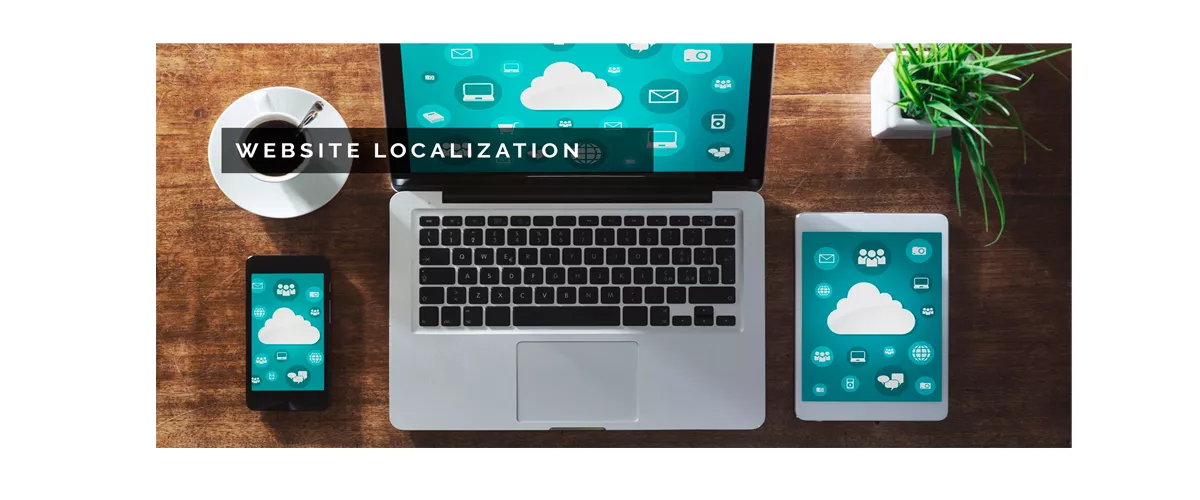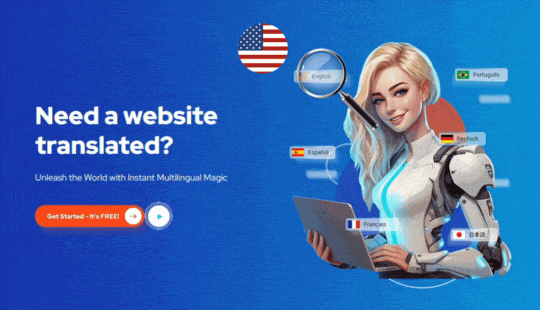
W przeszłości, kiedy to było bardzo trudne dla marek, aby dotrzeć do wielu osób, w dzisiejszych czasach dotarcie do kilku odbiorców jest dość łatwiejsze. Stwierdzenia takie jak "świat należy do Ciebie", "wszystkie możliwości są otwarte", "możesz zrobić wszystko lub iść gdziekolwiek" itp.
Jedną rzeczą jest uzyskanie dostępu do różnych rynków na całym świecie, a inną jest połączenie się z określonym rynkiem, zwłaszcza gdy rynek posługuje się językiem obcym.
Badania często pokazują, że około 40% kupujących online nie będzie patronować produktowi znajdującemu się na stronie internetowej, która nie używa ich języka. Wyobraź sobie, czego będziesz tracić, jeśli będziesz sprzedawać produkty na takim rynku bez użycia odpowiedniego języka.
Kiedy słyszysz słowo „lokalizacja”, być może zacząłeś myśleć o tłumaczeniu. Jednak lokalizacja to coś więcej niż tylko tłumaczenie. W szczególności oznacza to tworzenie i budowanie specjalistycznego doświadczenia użytkownika dla każdego użytkownika Twojej witryny, biorąc pod uwagę jego pochodzenie i lokalizację.
Dlatego w tym artykule omówimy dziesięć (10) najlepszych praktyk, które pomogą Ci zaktualizować właściwą lokalizację witryny.
1. Dokonaj szeroko zakrojonych badań na temat docelowego rynku: zawsze mówi się, że "Klienci mają zawsze rację, nawet jeśli się mylą". To dlatego, że wiedzą, czego chcą i mają rację co do wyborów, których dokonują, patrząc na to z własnej perspektywy.
Jedna rzecz, której powinieneś być szczególnie świadomy tendencji do zakładania. Łatwo jest ponieść porażkę, jeśli marki opierają swoje decyzje na zwykłych założeniach. Jeszcze gorzej jest zakładać, gdy wkraczasz na nowe rynki z nowymi lokalizacjami i kulturami, które mają wyraźne różnice w stylu życia i zainteresowaniach.
Zanurz się więc w obszernych badaniach i zbierz wystarczające informacje o rynku docelowym. Upewnij się, że to, co planujesz im zaoferować, jest tym, czego potrzebują, a nie tym, czego chcą. Po zapoznaniu się z ich potrzebami, następną rzeczą, którą powinieneś zbadać, są potencjalni konkurenci na tym rynku. Dzięki temu będziesz w stanie zdać sobie sprawę, jakie i jakie strategie działają w tym obszarze i którą strategię najlepiej zastosować, aby zdominować rynek.
2. Pozycjonowanie w wielu językach: bądź świadomy tego, kim są użytkownicy Twojego produktu. Znajomość ich ułatwi lokalizację. Będziesz mógł dotrzeć do serc odbiorców tylko wtedy, gdy będziesz w stanie dostrzec ich intencje, analizując, kim są, jakie produkty wybierają, jak odbierają komunikaty i jaką strategię marketingową mają skłonność do zakochania się.
Tutaj do gry wchodzi SEO. To jest generowanie ruchu w Twojej witrynie w sposób naturalny dzięki wynikom wyszukiwania w sieci. Aby osiągnąć taki ruch w Twojej witrynie, ważne jest, aby przetłumaczona witryna była zgodna z tym, czego prawdopodobnie szukają kupujący w docelowej lokalizacji. Tutaj musisz być trochę bardziej ostrożny, ponieważ pewne słowo kluczowe dla miejsca docelowego A może nie być właściwym słowem kluczowym dla miejsca docelowego B, niezależnie od tego, czy mówisz o tym samym produkcie, czy nie.
Dzięki zlokalizowanemu SEO Twoja witryna zyska przewagę na nowym rynku. Jeśli jednak nie zostanie to zrobione poprawnie, nie zdziw się, że nie będzie Cię widać na liście wyników, które się pojawiają, ponieważ użyto odpowiednich lokalnych słów kluczowych.
3. Dostosuj odpowiednio różnice kulturowe: jeśli chcesz odnieść sukces w nowej lokalizacji rynku, musisz być świadomy kulturowo i kulturowo wrażliwy. Bez nich nie będziesz nawet w stanie mieć odpowiedniej lokalizacji strony internetowej. Gdy zdajesz sobie sprawę z różnic kulturowych, nie będziesz mieć rzeczy, które będą określane jako obraźliwe lub żenujące przez użytkowników na twojej stronie.
Może to być zabawne, ponieważ to, co jest odpowiednie w tej lokalizacji, może być nieodpowiednie w tej lokalizacji. Aby uniknąć niezręczności, najlepiej będzie wielokrotnie sprawdzać wszystkie odniesienia kulturowe, które można znaleźć w Twojej witrynie, i upewnić się, że są one odpowiednie dla rynku, na który kierujesz reklamy.
Rozsądnie byłoby zaprosić zawodowych tłumaczy z tego regionu docelowego rynku, aby przejrzeli to, co zostało przetłumaczone. Tacy tłumacze mają zdolność szybkiego wykrywania i określania treści, które są odpowiednie lub nieodpowiednie dla lokalnego rynku.
4. Zezwalaj użytkownikom na przełączanie się między językami: większość osób, choć dobrze zorientowanych w języku angielskim, nadal wolą być oferowane pozdrowienia w ich lokalnym języku. Gdy użytkownicy mają możliwość przełączania się z jednego języka na inny, mają tendencję do korzystania z ich przeglądania na swojej stronie internetowej.
Chociaż tłumaczenie to nie wszystko, czym jest lokalizacja, odgrywa ono dużą rolę w dążeniu do uzyskania najlepszej formy lokalizacji strony internetowej.
5. Zbuduj wielojęzyczne zasoby marki: Twoje witryny nie powinny być twoim jedynym atutem. Twoja witryna powinna być interaktywna i wciągająca, aby odwiedzający mogli mieć przyjemny i angażujący czas. Powinno być kilka rzeczy, z którymi odwiedzający mogą wchodzić w interakcje na Twojej stronie. To będzie fascynujące mieć dźwięki, głosy i przewodniki stylu stworzone dla każdej z różnych miejsc masz na myśli. Upewnij się, że wszystkie treści do pobrania, takie jak raporty, książki elektroniczne, dokumenty projektowe itp.
Nie oznacza to, że musisz tworzyć swoją markę od podstaw przez cały czas, gdy wchodzisz w nową lokalizację rynkową. Zamiast tego lepiej jest tworzyć treści kawałek po kawałku, mając na uwadze wybraną lokalizację, ponieważ dzięki temu Twoja marka zachowa spójność na całym świecie.
6. Skorzystaj z narzędzia do tłumaczenia strony internetowej: zamiast komplikować proces lokalizacji strony internetowej, musisz obsługiwać podstawy tylko w najlepszy możliwy sposób, a także w preferowanym języku i formacie lokalizacji zainteresowania.
Stamtąd możesz ujednoliceć rzeczy za pomocą narzędzia do tłumaczenia stron internetowych, które są specjalnie zaprojektowane wyłącznie do tłumaczenia strony internetowej. Korzystanie z tych narzędzi pomaga uprościć proces tłumaczenia witryny i pomoże zautomatyzować ten proces.
7. Lokalizuj swoje media na swojej stronie internetowej: inne niż tłumaczenia słów na swojej stronie internetowej, są rzeczy, które wymagają uwagi. Obrazy, filmy, infografiki i grafiki na stronie internetowej powinny być zlokalizowane. To będzie lepiej odzwierciedlać na marki, jeśli te składniki multimedialne witryny są dostępne w formie, że odwiedzający mogą odnosić się do. Upewnij się, że media internetowe są dostosowane do potrzeb i języka nowych rynków. Spowoduje to, że twoich marek przyciągnie nowych nabywców.
8. Pamiętaj o projekcie strony internetowej podczas lokalizowania: będzie dobrze i miło, jeśli przetłumaczona zawartość jest czysta i jest słowem w imię renderowania materiału źródłowego. Jednak nie zawsze jest to najlepsze podejście. Powodem jest to, że zdania i akapity w odpowiednim języku nigdy nie będą miały takiej samej długości, a to ostatecznie wpłynie na sposób wyświetlania tekstów i innych treści stron internetowych w każdym z języków.
Twórz responsywne strony internetowe, które mogą dostosowywać się do wszelkich zmian, które mogą wystąpić w trakcie tłumaczenia na inne języki. Co ważne, uważaj na przyciski, które są wezwaniami do działania, ponieważ często padają ofiarą obcięcia.
9. Należy wziąć pod uwagę różnice w języku lokalnym: podczas tłumaczenia, należy nie tylko skupić się na prawidłowym tłumaczeniu słów, ale musi być również bardzo zbieżny z lokalnymi praktykami, takimi jak formaty daty i godziny.
Na przykład Amerykanie i Brytyjczycy mówią po angielsku. Jednak sposób, w jaki każdy zapisuje daty, jest inny. Forma brytyjska ma najpierw dzień, a następnie miesiąc. Inaczej jest w przypadku stylu amerykańskiego, w którym miesiąc jest pierwszy, przed dniem.
Małe, małe rzeczy, takie jak te, mogą mieć ogromne znaczenie, ponieważ pozwolą odwiedzającym zrelaksować się podczas przeglądania Twojej witryny.
10. Nieustannie angażuj się w testowanie: potrzeba czasu, aby uzyskać właściwą lokalizację. Zwłaszcza jeśli pracujesz na nowych rynkach w obszarach, które nie są zbyt znane wcześniej. To, co musisz kontynuować, to testowanie. Przetestuj, przetestuj i przetestuj ponownie. Testowanie pomoże Ci zrealizować obszary, które wymagały korekt, a następnie możesz je odpowiednio dostosować. Kiedy to zrobisz, odwiedzający będą świadkami przyjemnego doświadczenia na Twojej stronie internetowej.
Bądź czujny i obserwuj, który z Twoich produktów jest bardziej atrakcyjny dla odbiorców w nowej lokalizacji na rynku, przeprowadź test nowych słów i konsekwentnie oceniaj wyniki.
Możesz skutecznie dotrzeć na swój nowy rynek. Inaczej niż wcześniej, nie musisz już zawracać sobie głowy problemami z granicami lądowymi, ponieważ wraz z pojawieniem się Internetu możesz zamieniać różnych ludzi z różnych lokalizacji o różnym pochodzeniu w potencjalnych klientów.
Pamiętaj, kluczem jest właściwy proces lokalizacji. Nie chodzi tylko o tłumaczenie treści internetowych, ale ma to związek z tworzeniem wyjątkowych wrażeń dla odwiedzających Twoją witrynę.
Zacznij wcielić praktyki lokalizacyjne witryny, które zostały wymienione w tym artykule, aby pomóc Ci poznać nowych odbiorców i to, czego prawdopodobnie oczekują od Twojej marki. Kiedy zastosujesz wszystko, co zostało potraktowane w tym artykule, będziesz w stanie stworzyć i ładne i wspaniałe przeglądanie i zakupy dla każdego, niezależnie od ich lokalizacji na świecie.
Dzięki ConveyThis dowiesz się, jak przyspieszyć projekt lokalizacji strony internetowej.

